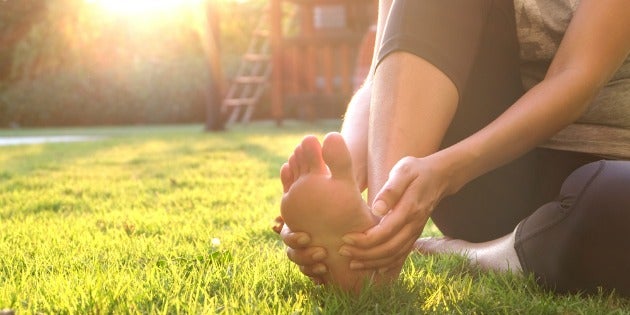Heading out the door? Read this article on the new Outside+ app available now on iOS devices for members! Download the app.

When it comes to the big posterior-chain movements — deadlifts, good mornings, kettlebell swings — you probably spend a lot of time warming up your hamstrings, glutes, lower back and calves. And that’s great, but you’re forgetting perhaps the most important part of the equation — the one that (literally) lies at your feet.
“The feet are a major component of the posterior chain,” says Andrew Yaun, DC, CCSP, owner of Optimal Sports Therapy in Fairfield, Connecticut, who explains that the complete posterior chain runs from the top of your head all the way down to the arch of your foot. “The muscles and fascia under the foot contribute to tension, and tight ankles and feet result in a stiffer posterior chain, won’t adapt to uneven ground and could even cause injury.”
Foot Feedback
The 33 joints within your feet should be able to move in multiple directions — forward, laterally and rearward — in order to provide sensory feedback to your body from the ground. This feedback tells your nervous system how to adapt to changes in terrain or balance and can let you know if you’re in the proper position for a lift or if you need to tweak something to improve your mechanics. If your feet are inflexible or stiff or if you wear thick-soled shoes to work out, this feedback is inhibited and could negatively impact your workout, according to Yaun.
The good news is that in about five minutes, you can vastly improve foot flexibility and reactivity and increase the mobility of your entire posterior chain as a result. Follow this six-step preworkout routine to flex your flip side — increasing power output and overall lifting potential.
Step 1: Test Yourself
Like they say, you can’t get where you’re going if you don’t know where you’re starting.
Take off your shoes and stand with your feet underneath your hips, knees straight but not locked. Slowly fold forward and reach your fingers toward the ground, going as far as you can without bouncing or forcing the stretch. Make a mental note of this starting point, then stand back up.
Step 2: Roll With It
To help release the fascia — the connective tissue on the bottom of your feet — do some passive massage with a lacrosse or tennis ball.
Place the ball on the floor and spend a minute or so rolling it underneath each foot, hitting the heel, toes, arch and ball. Move slowly, using moderate pressure, and spend extra time on tender or tight areas.
Step 3: Get Handsy
Passively mobilizing the many small foot bones with your hands helps activate the muscles deep within your feet while also increasing neural activity and internal temperature.
Sit on the floor and use both hands to manipulate one foot at a time for a minute each, bending your toes back and forth, spreading them out, twisting them in opposite directions. Here’s a key stretch from Yaun: Hold one foot with both hands and imagine trying to “roll” your foot into itself, spreading the top of your foot and instep with your palms while pressing up into your arch with your fingers.
Step 4: Spread ’Em
Stretching the tissues and fascia between your toes increases their ability to work independently and helps provide more accurate feedback from the ground up.
One foot at a time, spread your toes apart as far as you can and hold for a few seconds. (Sounds simple, but it might surprise you how challenging this is for some!) Repeat three to five times per foot, then stand up.
Step 5: Trace the Alphabet
Mobilizing your ankle encourages the release of synovial fluid, lubricating the joint, improving the relay of sensory feedback and decreasing the overall risk of injury.
Moving from the ankle (not the hip), draw the alphabet with each foot in the air. Exaggerate each letter and move slowly to stretch your ankle in every direction possible.
Step 6: Retest
Get out your notebook to record your results.
Assume the same forward-fold position you did in Step 1. How far did you reach this time? Compare your results to those from Step 1, then make a vow to always include this six-step plan as part of your warm-up.